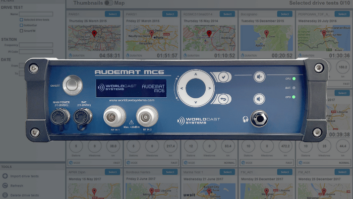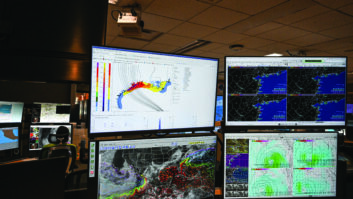Radio field reporters and producers can tell you many stories about the “one that got away” simply because of batteries going dead in the middle of an interview recording session.
The fear of losing an interview to dead batteries causes some of us to change batteries in our recorders before every major use. That can get expensive if you change out four disposable (single-use) batteries at a time. Rayovac’s line of rechargeable batteries makes that practice economical.
When I quit using a cassette deck to get field sound in 1998, I began using Rayovac rechargeable alkaline AA batteries for my MiniDisc recorders, the Sony MZR-37s. Rechargeable alkaline batteries come fully charged and you can put them in a machine right out of the blister pack. I’ve used the batteries and the portable PS1 charger for years and also have a PS3 charger in the office that can charge eight AA batteries at a time or four C or D cells.
At the 2002 Indianapolis 500, Rayovac sponsored driver Alex Barron in Indy Racing League competition. Its press release contained a boilerplate item about a one-hour battery charger for AA batteries. The batteries used in this new charger, called the PS4, weren’t the rechargeable alkalines, but were rechargeable nickel-metal hydride, or NiMH.
Recharging the NiMH batteries wouldn’t be a problem, because the MZR-37 has charging circuitry and the PS1 charger, which I carry in my field kit, will charge NiMH batteries, rechargeable alkalines and nickel-cadmium (NiCad) cells. The Rayovac PS4 works on AC and in that mode, four new NiMH AA batteries will come to full charge in an hour.
It also works on 12-volt power, which need three hours in the car for a full charge. Because I spend a lot of time in a car, I thought the new charger could solve problems and give me no excuse for missing a recording because of dead or low batteries.
The question here was whether the NiMH batteries would work as well for me as the rechargeable alkalines.
Time test
That question led to a somewhat unscientific test at the 2002 Indy Racing League season finale at Texas Motor Speedway.
During a lull in action, I tested four sets of AA batteries made by Rayovac. The first was a set of Renewal rechargeable alkalines in service for more than a year, probably closer to two; an almost new (one use) set of Renewal rechargeable alkalines, the NiMH rechargeables, and as a control, a set of Rayovac single use alkalines. I did not test NiCad cells because I wanted to test the products generally available from Rayovac.
The test consisted of making a stereo recording of 74 minutes, 59 seconds with a microphone and earbuds attached and marking seven to eight tracks while recording.
The criterion was the number of bars in the battery display of the MZR-37 MD recorder after the 74:59 test was complete, with four bars indicating nominally full and a flashing display indicating battery recharge or replacement. The control set of Rayovac single-use alkaline AA cells displayed four bars throughout the entire 74:59.
The set of rechargeable alkaline Renewal batteries in service for more than a year started to lose power at the 16-minute mark when three bars were displayed. At 21:44, the display went to two bars. At 31:19, the batteries went to one bar in the display until the 45:37 mark, when the single bar started to flash. The flashing continued to 58:55, when the unit shut down. An attempt to recharge these cells failed (although the charger light went out, the cells did not get warm, which they do when charging – it was time to recycle those batteries).
The almost-new rechargeable Renewal alkaline batteries did better on the test. At the 13:39 mark, the display went to three bars. Two bars were displayed at 19:09. At 26:06, the display went to one bar, and stayed there until the 72:19 mark, when the single bar started to flash, and flashed until the 74:59 mark. Those cells showed two bars before recharging in the PS1 charger and became warm, taking 1 hour and 45 minutes to recharge back to the four bar level. This is the usual performance.
The rechargeable NiMH batteries performed almost as well as the single-use alkalines. The display showed four bars until the 42-minute mark, when the display went to three bars, and stayed there until the end of the recording. It took 13 minutes in the PS4 rapid charger for the NiMH batteries to come back to full charge.
Pricing
The PS4 rapid charger charges both AAA and AA NiCad and NiMH batteries. I found one at retail for $29.99. Four NiMH AA batteries cost $10.99 at retail (Wal-Mart, Target, HomeDepot, etc.). The PS4 also charges NiMH and NiCad 9-volt batteries but can’t charge C and D cells.
The PS1 charger retails for $9.99. Rechargeable Renewal alkaline AA batteries were found for $6.99 for a set of four. The PS1 won’t recharge C, D or 9-volt batteries, just AAA and AA batteries. It will only run on AC power. The single-use Rayovac alkaline batteries are sold in four-, eight- and 12-packs. I’ve seen eight AA cells available for $3.99 at retail.
So what do I do when I forget to charge up the batteries? In theory, that ought not to happen because my MD recorders have come with a recharger circuit, and the PS4’s charge in a car or with a regular AC plug. The real world doesn’t run on theory, though.
For such instances, I have a set of the single-use Rayovac which will get me through those periods of brain fade, while the rechargeables are getting back up to full power.
If you can develop the habit of putting one set or batteries on charge while you’re using the other, like the TV camera folks, you might never need to buy a single-use battery again. The NiMH cells will lose some power in storage (over 30 days), like the NiCads. Rayovac suggests that the rechargeable alkalines can be charged up to 100 times, and the NiMH can be charged up to 1,000 times.
Both alkaline and NiMH systems have no appreciable memory effect as do NiCad batteries. Memory effect is simply the shortening of a discharge cycle, usually caused by recharging NiCad batteries before they are fully discharged.
The chart details the cost for using single-use batteries in two recorders (four AA alkaline cells) vs. the rechargeable NiMH and alkaline systems in the field over a two-year period. I’m assuming 36 weeks on the road each year and that you replace four batteries at least once a week with backup set at all times. I used Rayovac pricing for comparison and sales taxes weren’t included.
There may be generic store single-use alkaline brands that are less expensive, but over time, the rechargeable systems will pay for themselves in less than a year when compared to the cost of disposable single-use alkaline batteries. If you replace batteries more frequently, you will see a quicker payback.
Even if you follow my practice and have one set of single-use alkalines as a backup to the rechargeable battery system, you will still save serious money on batteries while not giving up anything in performance.
For more information, contact the company in Wisconsin at (608) 275-3340 or visit www.rayovac.com.







